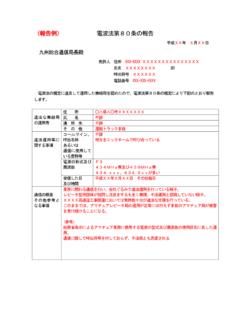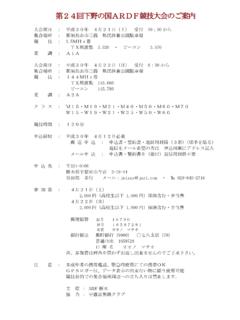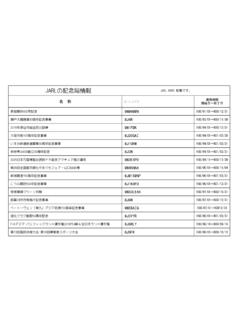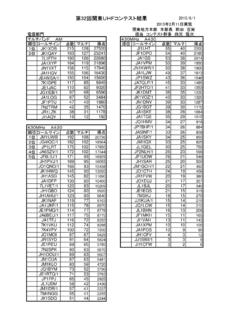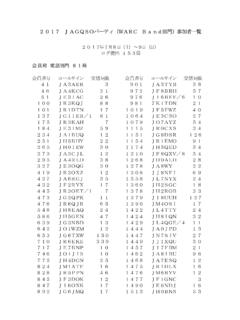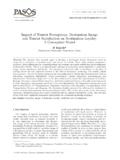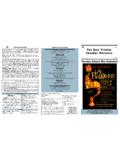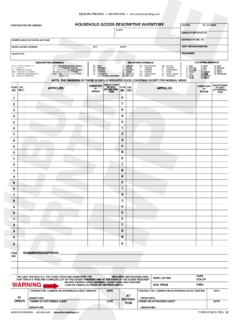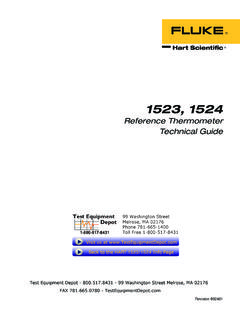Transcription of D-STAR System - JARL.COM
1 D-STAR System Technical Requirements for the Wireless System Voice Communication General Terms (1) Communication Method Half-duplex, digitized voice transmissions. (2) Communication Contents Digitized voice/audio signals and short data messages are supported. Voice and audio streams are transmitted synchronously to support communications quality reproduction. Data and voice/audio transmissions are interleaved. Transmitting Equipment (1) Modulation methods GMSK. QPSK. 4 FSK. (2) Data rate Maximum of Kbps (3) Voice encoding method AMBE (2020) converting at Kbps FEC at Kbps (4) Occupied bandwidth Maximum of 6 KHz Tx / Rx Switching time Less than 100ms.
2 Data Communication General Terms (1) Communication Method Simplex (2) Communication Contents Digital data stream is supported. 1. Transmitting Equipment (1) Modulation method GMSK. QPSK. 4 FSK. (2) Data rate Maximum of 128 Kbps (3) Occupied bandwidth Maximum of 150 KHz Switching time (Tx-Rx). Less than 50ms. Backbone communication General Terms (1) Transmission Method Full duplex. (2) Transmission Contents Backbone communication between repeaters containing multiplexed digitized voice/audio, user data, and link control data signals. Transmitting Setup (1) Output power Complies with FCC regulations.
3 (2) Modulation method GMSK. (3) Data rate Maximum of 10 Mbps (5) Occupied bandwidth Maximum of Multiplexing Method The multiplexing method for backbone linka is an ATM. The details of the specifications comply with the ATM protocol. Digitized voice/audio signals should be given the highest transmission priority. If more data is required, refer to ATM standards. ATM Cell (53byte) . Header Header Header . 5byte 48byte 2. 2. System Interconnection Requirements Wireless Communication Packet The frame structure of the wireless packet is below. Frame structure of a data packet Radio Header Data FCS.
4 ID MAC Header Bit Frame Flag Flag Flag Data Syn Syn. 1 2 3 Destina- Depart- Compa- Own Own P_FCS E_Len frame CRC. tion ure nion Callsign Callsign SA DA Type RepeaterRepeater Callsign 1 2. Callsign Callsign 64bit 15bit 1 1 1 8byte 8byte 8byte 8byte 4byte 2byte 2byte 6byte 6byte 2byte 46-1500byte 4byte byte error correction 660bit . The explanation of the data frame structure the Radio Header follows. (1) Bit Syn. (Bit synchronization): Repeated standard 64-bit synchronization pattern (for GMSK 1010, for QPSK 1001). Transmission direction is from left to right. (2) Frame Syn. (Frame synchronization) : 15bit pattern (111011001010000).
5 Transmission direction is from left to right. (3) Flag 1 (8 bit): Flag 1 uses upper 5 bits and lower 3 bits separately. A detailed explanation follows. bit Distinguishes between voice and data communications. 7(MSB) 1 indicates data, 0 indicates voice. bit 6 Identifies if the signal goes through a repeater or is a direct communication between terminals.(1for repeater, 0. for terminal). Recognizes if communication interruption exists. 1. bit 5. indicates interruption, 0 indicates no interruption. bit 4 Identifies control signal/data represents control signal and 0 represents regular data signal.
6 (Voice signal included). bit 3 1 represents an urgent priority signal,0 represents a normal priority signal. For signals with a 1 in this position, the receiver will open squelch etc. Note, Urgent signal in this document does not mean Urgency signal as defined in International Radio Law. It means an urgent priority signal for use in emergency communications. 3. bit 2,1,0 111=repeater station control flag, while the repeater is controlled, the flag is 111 and the data frame contains control data. 110=Auto reply 101=Unused(spare). 100=Resend flag, requests resending previous frame 011=ACK flag,Treated as ACK flag 010=No reply flag, Indicates no reply is available 001=Relay unavailable flag, Indicates unsuitable relaying conditions.
7 000=NULL, No information. Upper bit Bit 7 6 5 4 3. 1 Data Relay Interruption Control Urgent 0 Voice Direct No interruption Control Urgent Lower bit 2 1 0 Function Note 1 1 1 Repeater Repeater Control Control Mode 1 1 0 Auto Reply Used for Auto Reply 1 0 1 (Unused) (Unused0. 1 0 0 Resend Requests Resend 0 1 1 ACK ACK flag 0 1 0 No Response Indicates No Response Available 0 0 1 Relay Indicates Relay Unavailable Unavailable 0 0 0 NULL NULL. (4) Flag 2. Flag 2 is for future expandability and is defined below. Bit 7 6 5 4 3 2 1 0 Note . Flag Default a. flag is used as an format descriptor.)
8 This is available not only for the increase and decrease of a figure of callsign but also for ID, which is not used as callsign rather than numeric. b. flag is used only a creator or a manufacturer of the equipment. (5) Flag 3. Flag 3 is used to match control functions to protocol versions, which may be upgraded in future software versions. Bit Meaning Function 00000000 No Default Function 00000001. Use for future to Undefined expansion 11111111. 4. (6) Destination repeater Callsign can have a maximum of 8 ASCII letters and numbers. Blanks should be filled with a space character.
9 In the case of direct communication, it inserts and fills the blanks with a space character. The use of this field is described in section (7) Departure repeater Callsign can have a maximum of 8 ASCII letters and numbers. Blanks should be filled with a space character. In the case of direct communication, it inserts and fills the blanks with a space character. The use of this field is described in section (8) Companion Callsign can have a maximum of 8 ASCII letters and numbers. Blanks should be filled with a space character. The use of this field is described in section (9) Own Callsign 1 can have a maximum of 8 ASCII letters and numbers.
10 Blanks should be filled with a space character. This field same as voice frames. (10) Own Callsign 2 is used when to add suffixes to a callsign or a additional destination address information. Own Callsign 2 can have a maximum of 4. ASCII letters and numbers. Blanks should be filled with a space character. (11) P_FCS is the Radio Header CRC-CCITT checksum, computed by the following expression. G(x) = x16 + x12 + x5 + 1. (12) The data frame of the packet is constructed as an Ethernet packet. (13) FCS is the checksum of the Ethernet data payload. It is a CRC-32 checksum as defined in ISO3309 and is computed by the following expression.

